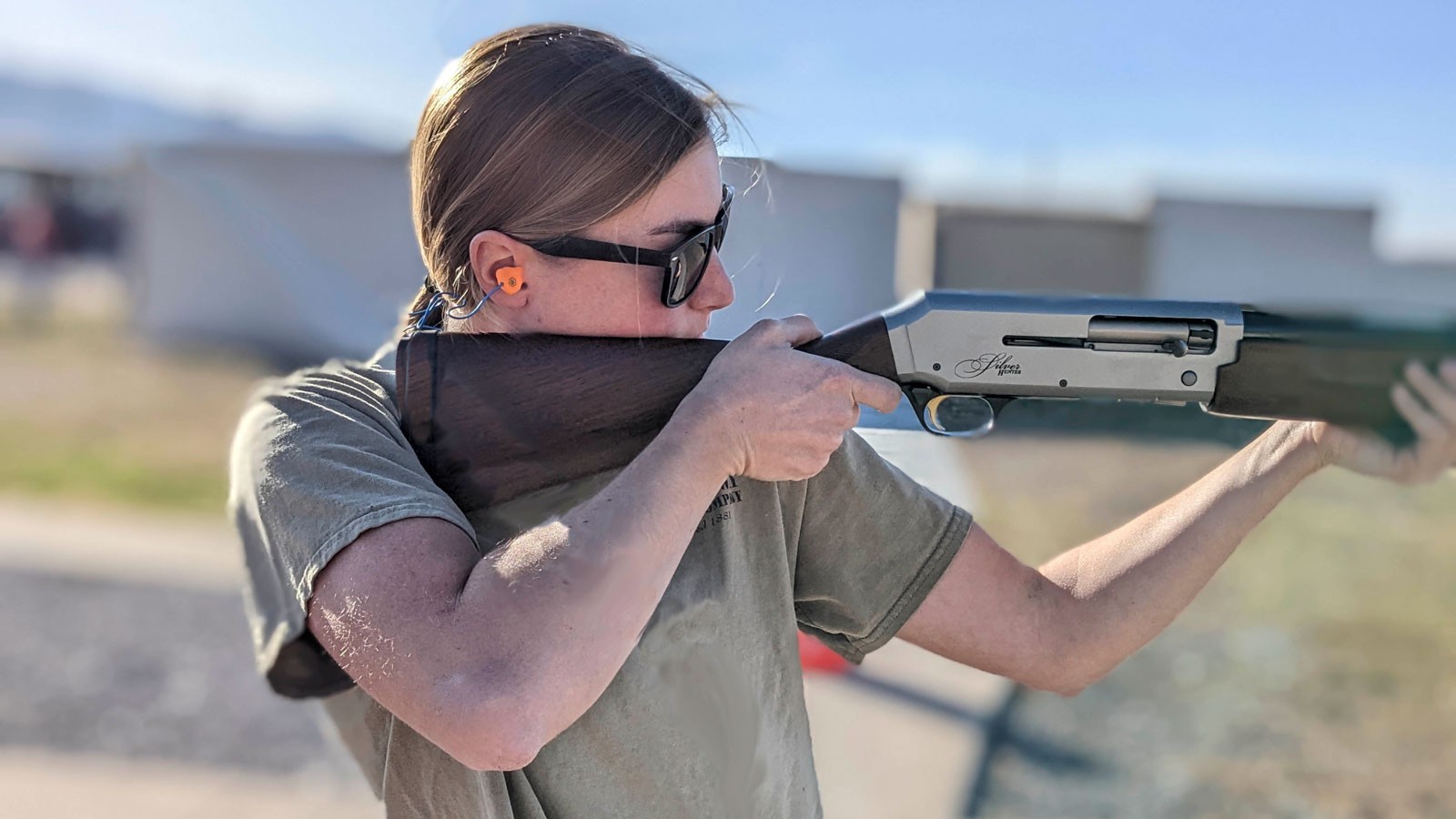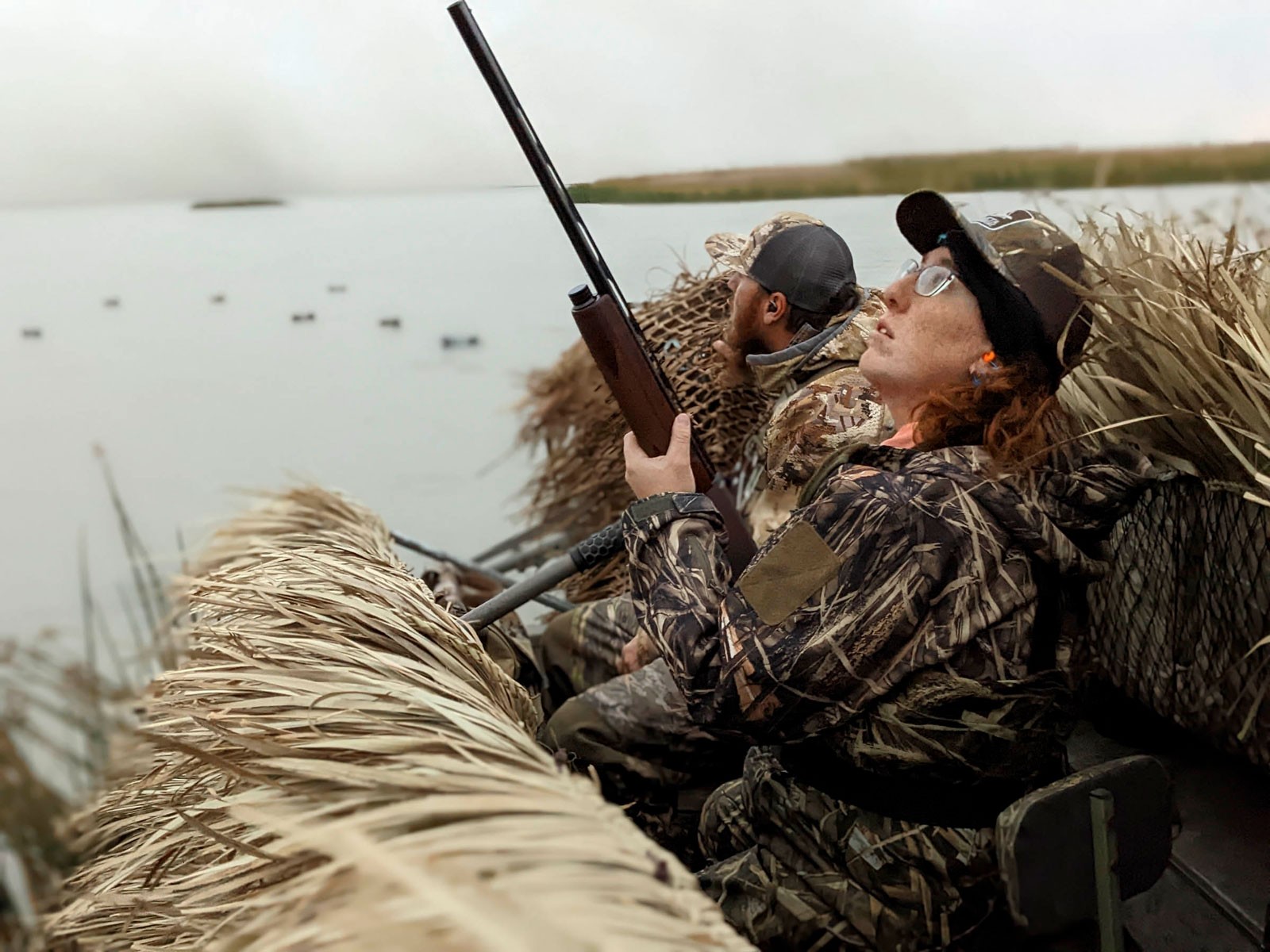Happy Hunting: Students, Faculty Experience First-Time Duck Hunt Through Ambassador Program
By Lael Gilbert |
Graduate student Christine Sandbach holds an aim during shooting practice at the public shooting range in preparation for her first duck hunt.
Graduate student Rory Eggleston had been waiting patiently since before dawn, in a well-camouflaged duck boat lodged snugly in a thick clump of bulrush. Now the sun was up, and she and her volunteer hunting mentor from Delta Waterfowl, Austin Reed, sat with shotguns resting on knees, scanning the sky for a passing mallard or widgeon at the Bear River Migratory Bird Refuge.
Eggleston had worked hard to prepare for this moment, taking hunter education classes, participating in shooting practice provided by the Utah Division of Wildlife Resources (UDWR) Hunter Education Program, and engaging in plenty of group discussions about the role hunting plays in the management of natural resources. Now it was time to squeeze the trigger for herself.
Not that she needed much convincing. She had spent her childhood in a Wyoming community where hunting was a way of life for many people. But this was the first time she had the chance to try it firsthand — as it was for most of the graduate students and faculty participating in this year’s Delta Waterfowl University Hunting Program coordinated by Dave Dahlgren, associate professor and extension specialist from Wildland Resources in the Quinney College of Natural Resources.
The program, targeted toward natural resources students and faculty who have little-to-no hunting experience, offers a mentored opportunity to participate in the sport, Dahlgren said. Hunting, after all, isn’t easy to just jump into. There is a lot of essential knowledge — regulations, etiquette, skills, safety — and expensive equipment needed to participate. With support from Delta Waterfowl, UDWR and USU, this program gives graduate students and faculty a chance to sample a hunting experience without the full financial commitment, offering loaned waders, ammunition, firearms, gear, classes and a mentored field experience.
Reed was a patient mentor for the new hunters — as a lifetime of waiting for birds probably taught him to be. He answered a peppering of questions, all the while keeping a wary eye on the sky, hoping to offer the newbies a chance to bring home an actual bird. He offered good-humored perspective about every aspect of the experience, from best shooting techniques to what to do if your boot gets stuck in the mud.
The goal of the program is to start bridging a cultural gap between hunters and non-hunters, especially among those who will go on to manage natural resources, Dahlgren said. Hunting is an integral part of conservation in North America, a role that can easily be underestimated or misunderstood, especially among people without firsthand experience, he said.
Even non-hunters benefit from hunting. The trail you walked last summer, the lake you paddled, the grove of trees where you stopped to watch songbirds may well be there thanks to a hunter or angler, Dahlgren said. Many people don’t realize that hunter dollars offer significant support for wildlife and land conservation. Funds from the Federal Duck Stamp (required for all waterfowl hunting), go almost entirely toward waterfowl and habitat conservation, including the National Wildlife Refuge System (almost 6 million acres since 1934).
Excise taxes on firearms and ammunition are the main funding source for state wildlife agencies, supporting hunter education and outdoor recreation access (more than $14 billion nationally since 1937). This ongoing influx of cash to state wildlife agencies supports recovery and management of deer, turkey and many non-game species, with benefits to hunters and non-hunters alike, Dahlgren said. But the number of people participating in hunting has been declining, creating a risk for ongoing financial support for conservation.
At the Bear River Migratory Bird Refuge, sound floated across the water — a sigh of wind, a patter of raindrops, the occasional ill-blown duck call from another beginner from somewhere across the marsh.
“There’s no better conservationist than somebody who doesn’t know how to use a duck call,” Reed joked.
After a morning on the water, volunteers from Delta Waterfowl didn’t disperse until they made sure the USU participants knew how to clean the meat from the birds they bagged, and how to prepare it for the table. They offered a wild-game lunch with summer sausage, slow-cooked barbecue, and jerked duck.
Dahlgren and the hunter volunteers from Delta Waterfowl also hope this program can hook a few new enthusiasts to the sport.
“This program is important to help people get beyond simple stereotypes,” said Jeff Adams, regional director for Delta Waterfowl, who co-organized the event. “We have boats and guns and a deep passion — it’s an honor to be able to take folks out and share that with them. Hopefully they’ll want to come back and try the whole experience again.”
Graduate student Rory Eggleston and mentor Austin Reed scan the sky during a duck hunt, a part of the Delta Waterfowl University Hunting Program that included hunter education classes, shooting practice, and discussions about the role hunting plays in the management of natural resources.
WRITER
Lael Gilbert
Public Relations Specialist
Quinney College of Natural Resources
435-797-8455
lael.gilbert@usu.edu
CONTACT
Dave Dahlgren
Professor
USU Department of Wildland Resources
435-881-1910
dave.dahlgren@usu.edu
TOPICS
Wildlife 141stories Land Management 124stories Wildland 97stories Culture 78storiesComments and questions regarding this article may be directed to the contact person listed on this page.









